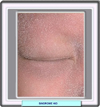 |
El síndrome KID debe su nombre a las iniciales en inglés de queratitis, ictiosis y sordera, los tres signos característicos de la enfermedad. También es llamado síndrome de Desmons o síndrome de Senter |
 |
La enfermedad se caracteriza por una hiperqueratosis generalizada |
 |
El síndrome KID se debe a mutaciones en el gen GJB2 que codifica una proteína de adhesión, la conexina 26 |
 |
En el 95% de los casos se produce una opacificación de la córnea debida a una neovasculatrización |
 |
REFERENCIAS
- Burns, T. Rook's Textbook of Dermatology. 4 volúmenes(2005) Blakwell. 4768 páginas
|
 |
- KID Syndrome Associated with Features of Ichthyosis Hystrix. By: Nousari H, Kimyai-Asadi A, Pinto JL. Pediatric Dermatology, (2000), Vol. 17 Issue 2, p115-118 (ref.1)
|
 |
- Rogers M. Nail manifestations of some important genetic disorders in children. Dermatologic Therapy, (2002), Vol. 15 Issue 2, p111-121 (ref.2)
|
 |
- Jan AY, Amin S, Ratajczak P, Richard G, Sybert VP.Genetic Heterogeneity of KID Syndrome: Identification of a Cx30 Gene ( GJB6) Mutation in a Patient with KID Syndrome and Congenital Atrichia. Journal of Investigative Dermatology, (2004), Vol. 122 Issue 5, p1108-1114 (ref.3)
|
| |
- Tabet R, Smadja J, Hoang-Xuan T. KID syndrome: pathogenesis of ocular lesions. Fr Ophtalmol. 2005 May;28(5):521-6
|
| |
- Derse M, Wannke E, Payer H, Rohrbach JM, Zierhut M. Successful topical cyclosporin A in the therapy of progressive vascularising keratitis in keratitis-ichthyosis-deafness (KID) syndrome (Senter syndrome).
Klin Monatsbl Augenheilkd. 2002 May;219(5):383-6.
|
 |
Monografía creada el 14 de Agosto de 2005. Equipo de Redacción de IQB |
| |
|








